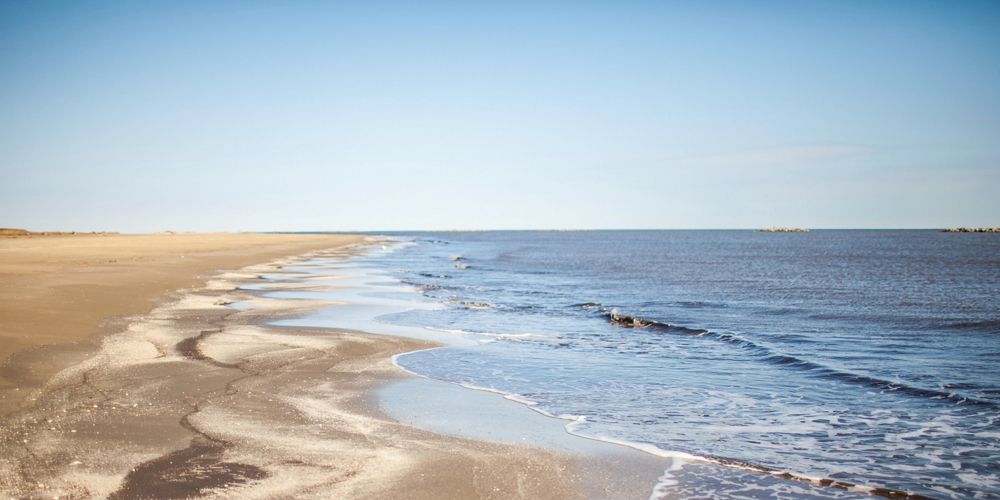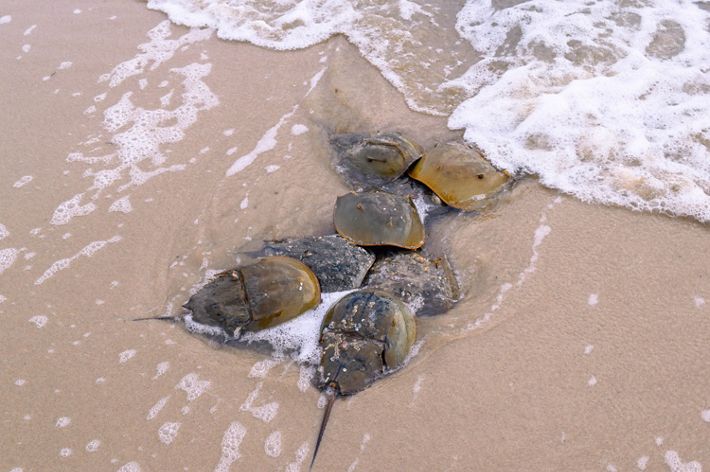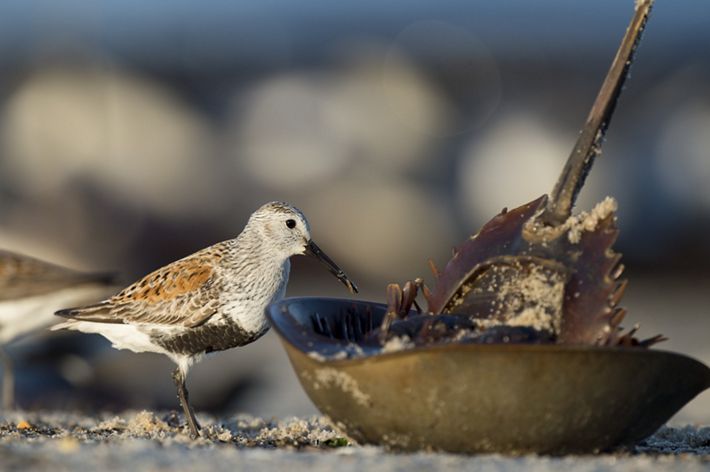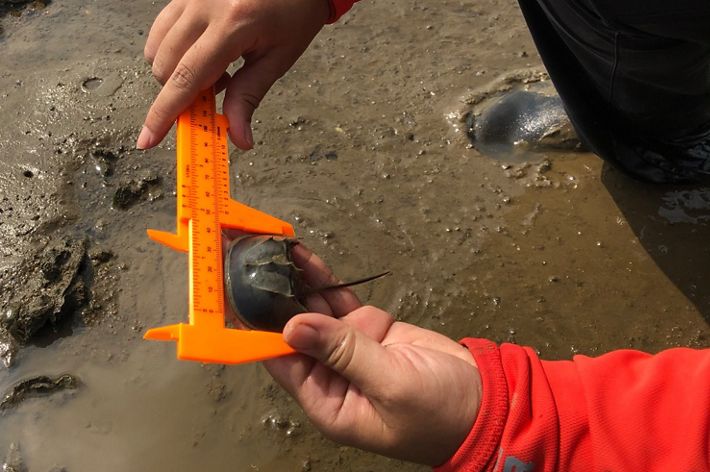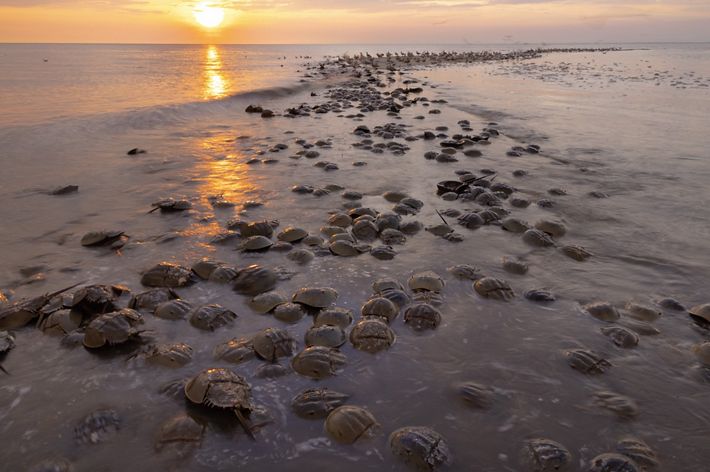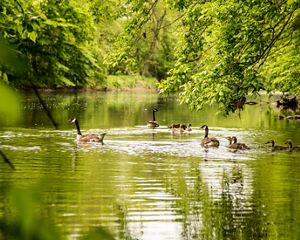
Horseshoe Crabs Learn how this iconic species plays an essential role in the health of our coastal ecosystems. © Karine Aigner
Each spring, the Delaware Bay becomes the site of one of the natural world’s most spectacular and ancient phenomena: the spawning of horseshoe crabs. From early April through early June, the crabs crawl onshore from deep Atlantic waters to spawn under full and new moons, just as they have for 450 million years.
Stay in Touch
Sign up to receive monthly e-mail conservation news, event info, & updates from Delaware.
The horseshoe crab eggs attract other visitors, too. Migratory birds like the iconic red knot are drawn to the beaches during the spawning period. The red knots require sustenance as they continue their nearly 10,000-mile journey to their Arctic breeding grounds, and the Delaware Bayshore therefore becomes a critical waypoint.
On moonlit nights in May and June, thousands of the crabs crawl ashore on Delaware Bay beaches at high tide to lay eggs, as they have for 450 million years. The crabs are sometimes so dense that the water’s edge looks like a road paved with brown shells.
The greatest concentration of horseshoe crabs typically occurs in the middle reaches of the Delaware Bay from Slaughter Beach to Kitts Hummock. By July, the crabs have largely completed their spawning and returned to the ocean.
Why Are Horseshoe Crabs Interesting?
Horseshoe crabs are an ancient species largely unchanged over hundreds of millions of years, sometimes referred to as “living fossils.” They are not, in fact, crustaceans at all, but are instead arachnids more closely related to spiders and scorpions. They are generally not dangerous to humans but should be observed from a distance.
Watermen harvest horseshoe crabs to use as bait for eel and whelks. The crab’s unique blue blood is also rich in oxygen-carrying chemicals and has historically been used in medical research, vaccine development and pharmaceutical applications.
Why Are Horseshoe Crabs Important for Birds?
Horseshoe crab eggs are critical for sustaining migratory birds each year. The threatened red knot, for example, flies from wintering grounds in South America to the Arctic each spring, stopping in Delaware along the way to fuel up on horseshoe crab eggs. Without the food, the red knot cannot complete its journey.
In this way, the future of the two species are linked. If horseshoe crab populations drop due to pressures from climate change, overharvesting or habitat loss, the red knot will face a critical food shortage.
Spring offers an excellent opportunity to view these shorebirds on the Delaware beaches. However, bird watchers are advised not to disturb the birds, as they need to store every available bit of energy for their long flight.
Why Do We Count Horseshoe Crabs?
Evidence suggests that the crabs are over-harvested in North America, which has led to a harvesting ban in New Jersey and restrictions in Delaware. Knowing how many horseshoe crabs there are helps fishery managers develop effective policies for managing populations.
Every May and June, during the evening full and new moon high tides, volunteers count horseshoe crabs at 23 beaches along the shores of the Delaware Bay in both Delaware and New Jersey. This data is used to create the annual Delaware Bay Horseshoe Crab Survey which is utilized by the Atlantic States Marine Fisheries, state agencies and scientists.
How Does TNC Help Protect Horseshoe Crabs?
In New Jersey, TNC participates in the annual census and reports its findings as part of the collective effort. In Delaware, TNC's Milford Neck Preserve provides nearly a mile of undeveloped beachfront that hosts thousands of spawning crabs and hungry shorebirds. However, these fragile coastal habitats are facing threats from climate change and rising seas.
Quote: Will Helt
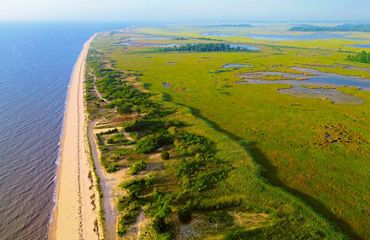
Delaware’s Bayshore has long been recognized for the critical habitat it provides like beaches, dunes, marshes and maritime forests to horseshoe crabs, red knots and other migratory birds and fishes.
TNC’s Oceans and Coasts program in Delaware is working with partners to strategically plan for land protection efforts that will allow for the natural inland migration of marsh and beaches. If the sandy beaches of the Delaware Bay disappear, horseshoe crabs could disappear, too, without the proper habitat needed for spawning.
“Delaware’s Bayshore has long been recognized for the critical habitat it provides like beaches, dunes, marshes and maritime forests to horseshoe crabs, red knots and other migratory birds and fishes,” says Will Helt, director of the Oceans and Coast program in Delaware. “Today’s challenge is ensuring these habitats and ecotones persist in the face of climate change. As sea levels rise, it is important to provide the space and stewardship for these natural systems to adapt accordingly. TNC aims to ensure critical ecosystem migration pathways remain intact and improve the resilience of important habitats through the use of nature-based solutions so that they can continue to be a valuable resource for the animals that rely on them every year."
Explore our Coastal Resilience Roadmap
A strategic framework designed to identify nature-based solutions and policy approaches that strengthen Delaware’s coastline against future challenges, benefiting both local communities and native species like the Horseshoe Crabs.
